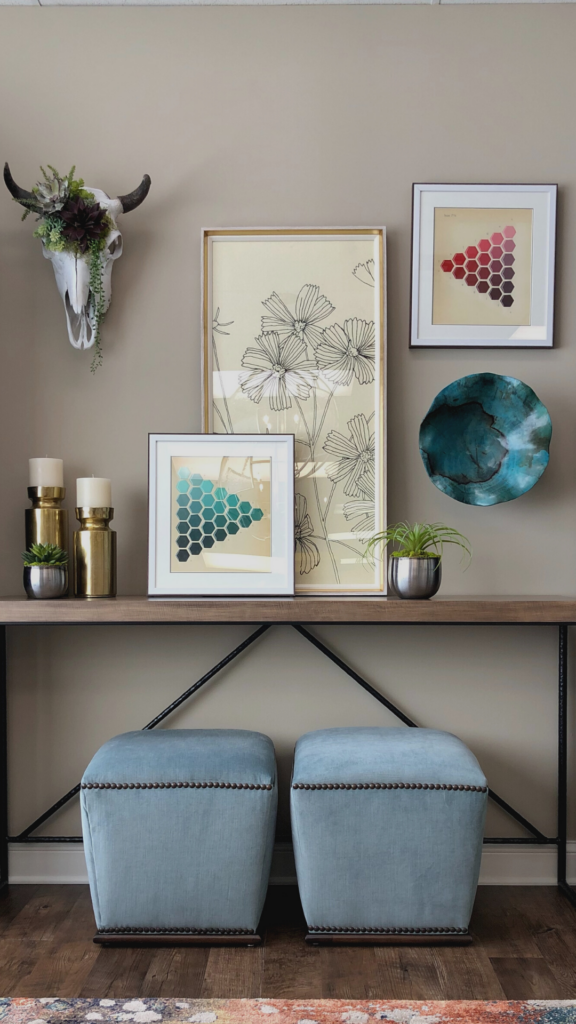10 Accent Wall Design Tips & Inspiration
Looking for a way to enhance the look and feel of a particular room in your home without making any major changes?
Or maybe you’re undertaking a significant home remodeling project and you’re searching for creative ideas and inspiration?
If so, an accent wall may be an appealing solution.
Read on for a closer look at accent walls, why people love them and how to make the most of an accent wall in your home.
We’ve also put together a roundup of “do’s” and “don’ts” aimed at helping you energize your living space with an accent wall.
What is an Accent Wall?
When you think of painting a room, you probably think of painting the entire room. An accent wall takes a different approach.
Instead of painting all four walls of a room, you select just a single wall to be the accent wall. This interior design technique can be used in any room of the home—from bedrooms and bathrooms to living rooms, kitchens, and dining rooms.
Also called “feature walls,” accent walls have many benefits, including:
- They are wonderful opportunities for self-expression with the potential to add personality and individuality to your home. A playful or glamorous accent wall is a simple way to take a room from dull to dazzling.
- They can be used to make your home feel more cohesive, harmonious, and fluid. For example, if a particular color is present in other areas of your home, introducing it as an accent wall in a different room is a seamless way to continue a color scheme or theme.
- We’ve all heard the expression, “Less is more.” Painting an entire room a bold or vibrant color can not only be overwhelming but may also become tiresome over time. An accent wall lets you make a bold statement without taking over.
- They can be used to highlight or create focal points in rooms. Looking to draw the eye to a particular area of interest, design element or piece of art, or to create one to add visual interest or make a room more dynamic? An accent wall delivers.
Accent Wall Tips and Tricks
While the sky’s the limit when it comes to accent walls, knowing where to begin can be a challenge. To that end, we’ve rounded up 10 “do’s” and “don’ts” to help get you started and give you some direction.
1. Choose the Right Wall
Do: Be intentional when choosing an accent wall. It’s not just about the accent wall color, but also the surrounding walls. Rooms with strong architectural features or lots of windows may not be the best candidates for accent walls. Instead, consider adding an accent wall to a room that feels like it’s missing something.
Neutral rooms are excellent candidates for accent walls, as are larger rooms with lots of natural light. Oftentimes, accent walls are positioned opposite to the door to a room to make the biggest impact. However, this isn’t always the case.
Don’t: Forget to consider the “fifth wall,” AKA the ceiling. While not technically a wall, accent ceilings can have the same impact.
2. Pick an Idea and Stick with It
Do: Once you’ve given your accent wall placement, style, and other aspects, go for it! There is no “right” or “wrong” when it comes to an accent wall—lead with what you love.
Don’t: Rush to decisions and action. Taking your time is the best way to ensure you’ll land on an accent wall you love. (That said, design mistakes happen. Don’t love the outcome? You can always change it.)
3. Consider Options Other Than Paint
Do: Think outside the paint box—or can. While a bold coat of paint is one way to go with accent walls, it’s far from the only way. Painted accent walls can incorporate prints and patterns (we love stripes!) as well as specialty paint finishes, such as metallics.
And while paint color is one of the most common ways to embrace the accent wall, you can also change things up with materials and finishes. Wallpaper, stone, brick, tile, wood, and even fabric-draped accent walls are all intriguing alternatives to paint. Other options include floor-to-ceiling shelving and photo or art gallery walls.
Don’t: Trap yourself inside the box of what you think is acceptable. The whole point of an accent wall is to think outside the box of expectations. Always fancied wallpaper, but afraid it will make your room feel claustrophobic? A wallpapered accent wall can offer the best-of-both-worlds.
4. Get Creative
Do: Take a risk! As small investments with big potential payoffs, accent walls are ideal opportunities for swinging big. After all, they exist for the purpose of making a statement. So go for it! A few creative spins on accent walls we’ve seen include Shaker shingles, paneling, reclaimed wood, wood cladding, wall murals, stencils, wall decals, chalkboard, and even self-made paint effects.
Don’t: Be creative just for creativity’s sake. Every design element of your home should be purposeful.
5. Plan Your Colors
Do: Understand that accent walls don’t live in vacuums. They exist within the aesthetic look and feel of your home. Choosing your accent wall color isn’t just about picking a color or material you love and going with it. You should also consider other factors, such as the color of adjoining walls as well as your desired result.
Don’t: Underestimate contrast or lack thereof. Contrasting a bright accent wall against white walls can look contemporary and modern; however, it can also look sterile or stark. Conversely, pairing a dark accent wall with equally dark walls can make a room feel more closed in.
6. Decide on the Wall’s Purpose
Do: Think about what you’re trying to accomplish with your accent wall. Are you looking to inject color into the space? Create flow or cohesion with another area of your home? Add a touch of glitz or glamour? Your accent wall can accomplish each of these things—but you need to know your goal in order to achieve it.
Don’t: Assume a successful accent wall is just about throwing an eye-catching coat of paint on a wall and calling it a day.
7. Use It to Bring Interest to a Transition Space
Do: Consider adding an accent wall to your transition spaces. These often neglected areas of the home can be brought to life with a stunning accent wall. Mindful accent wall design can even make a long, dark corridor feel brighter and more welcoming.
Don’t: Overlook entryways, hallways, and corridors!
8. Make Sure Your Wall Has Symmetry
Do: Acknowledge the importance of symmetry. While good interior design doesn’t have to be matchy-matchy, balance is everything. For example, introducing an accent wall and then obscuring it with furniture and accessories not only detracts from its impact, but can also make your room feel heavy and out of scale.
Don’t: Be careless when designing and executing your accent wall. One of the best ways to make sure your accent wall project has the desired result? Be rigorous about everything from prep to execution. For example, think you can get away without taping off a room with painters tape? Think again. For the most professional results, adhere to best practices.
9. Follow the 60-30-10 Rule
Do: Hailed by Apartment Therapy as “the key to color confidence”, the 60-30-10 formula proposes that of a space’s color palette, 60 percent should be the dominant or main color; 30 percent should be a secondary color (or texture); and 10 percent should be an accent color.
Don’t: Be afraid to go rogue occasionally—especially if inspiration strikes and you feel compelled to tinker with the formula or toss it aside completely. Rules are sometimes made to be broken.
10. Incorporate Pattern and Texture
Do: An accent wall painted in a solid color is the easiest and least expensive way to go. However, as mentioned earlier, it’s far from the only option. Playing with pattern and texture opens the door to an entirely different and exciting realm of possibilities—from florals and chevron to graphic patterns and even animal prints!
Don’t: Assume outside-the-box accent walls are too difficult or complex to pull off. In some cases, all you need is high-quality painter’s tape, some time, and attention to detail.
Whether you’re searching for a way to liven up one room of your home or starting to think about a large interior design or new home remodeling project, accent walls can have a transformative impact. But they’re just one of many interior design tools and techniques that we love at Che Bella Interiors Design + Remodeling.
If you live in Minneapolis, St. Paul, or the greater Twin Cities area, our experienced, professional, and enthusiastic team is eager to help you articulate your interior design vision and bring it to life with our comprehensive interior and home design services. From design, layout and space planning to custom furniture and window treatment selection, we’re ready to help you create a space that is beautifully yours.








